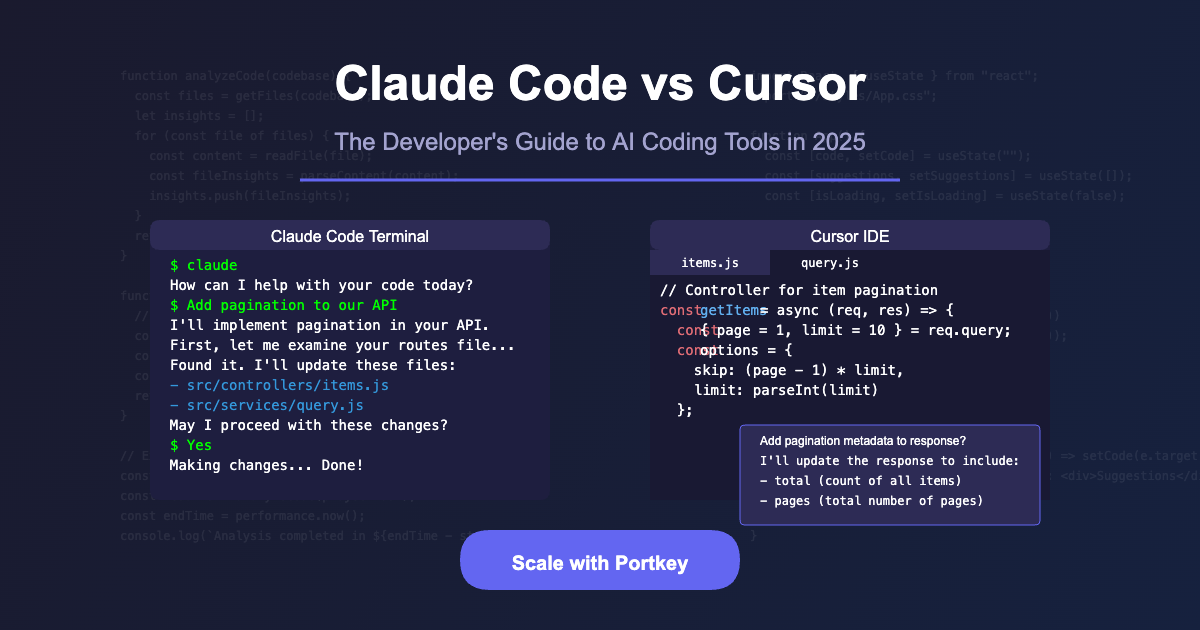Cursor AI vs Claude Code: The 2025 Showdown for AI-Assisted Development
Two leading AI coding assistants have released major updates in 2025. This comparison examines their new capabilities, pricing models, and which tool best fits different developer workflows.

The AI Coding Assistant Battle Heats Up
Cursor AI and Claude Code have emerged as the dominant forces in AI-assisted development, each releasing significant updates throughout 2025. Both platforms promise to accelerate coding workflows, but they take fundamentally different approaches to architecture, pricing, and feature implementation. For developers evaluating which tool to adopt, understanding these distinctions is critical.
Core Architecture and Integration Differences
Cursor AI operates as a standalone IDE built on VS Code foundations, offering developers a complete development environment with integrated AI capabilities. This approach provides a unified workspace where coding and AI assistance exist seamlessly within the same interface.
Claude Code, by contrast, integrates directly with Anthropic's Claude models through a web-based interface and API-first design. This architecture emphasizes flexibility and allows developers to leverage Claude's reasoning capabilities without abandoning their existing editor preferences.
Key architectural implications:
- Cursor AI: Full IDE replacement with offline capabilities
- Claude Code: Lightweight integration compatible with multiple editors
- Cursor AI: Faster local inference for certain operations
- Claude Code: Access to latest Claude model updates via API
Feature Comparison: 2025 Updates
Cursor AI's Latest Enhancements
Cursor's 2025 roadmap introduced improved context awareness, allowing the assistant to maintain better understanding of large codebases. The platform now supports more granular control over which files contribute to context, reducing token usage and improving response accuracy. Real-time collaboration features have also expanded, enabling multiple developers to work within the same Cursor session.
Claude Code's Competitive Moves
Claude Code doubled down on reasoning capabilities, leveraging Anthropic's extended thinking features for complex architectural decisions. The platform introduced improved code review functionality and enhanced debugging workflows. Integration with popular version control systems became more seamless, with native GitHub and GitLab support.
Pricing and Accessibility
Cursor AI operates on a freemium model with paid tiers starting at $20/month for professional developers. The pricing structure includes usage-based costs for API calls beyond included limits, which can become expensive for heavy users.
Claude Code pricing depends on which Claude model tier you select. Developers can use Claude 3.5 Sonnet through Anthropic's standard API pricing ($3 per million input tokens), making it potentially more cost-effective for teams with predictable usage patterns. However, the extended thinking features carry premium pricing.
Pricing considerations:
- Cursor: Predictable monthly subscription, but variable costs possible
- Claude Code: Pay-as-you-go model favors consistent, moderate usage
- Cursor: Includes local models for cost reduction
- Claude Code: Requires API credits for all operations
Practical Recommendations
Choose Cursor AI if you:
- Need a complete IDE replacement with minimal setup
- Prefer offline-capable development environments
- Work on projects requiring consistent, predictable costs
- Value integrated version control and collaboration features
Choose Claude Code if you:
- Want to maintain your existing editor setup
- Prioritize access to cutting-edge reasoning capabilities
- Have variable coding workloads with unpredictable usage
- Require flexible, API-first architecture
The Verdict
Neither tool is universally superior. Cursor AI excels as a comprehensive development environment for teams seeking an all-in-one solution. Claude Code shines for developers who demand flexibility and access to Anthropic's latest model innovations without committing to a new IDE.
The choice ultimately depends on your workflow priorities: integrated simplicity versus architectural flexibility, and predictable costs versus pay-per-use economics. Both platforms continue evolving rapidly, and developers should expect significant feature additions throughout 2025.
Key Sources
- Portkey AI: Comprehensive comparison of Claude Code and Cursor capabilities
- Pragmatic Coders: Detailed feature matrix and performance benchmarking
- Augment Code: Broader AI development tool ecosystem analysis



